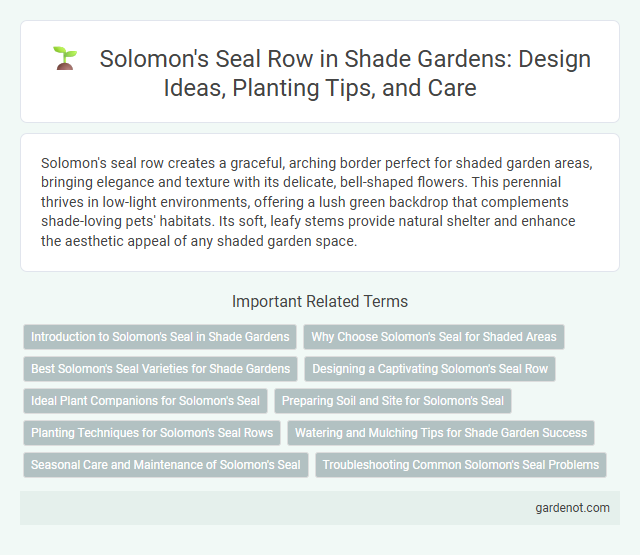Solomon's seal row creates a graceful, arching border perfect for shaded garden areas, bringing elegance and texture with its delicate, bell-shaped flowers. This perennial thrives in low-light environments, offering a lush green backdrop that complements shade-loving pets' habitats. Its soft, leafy stems provide natural shelter and enhance the aesthetic appeal of any shaded garden space.
Introduction to Solomon's Seal in Shade Gardens
Solomon's Seal (Polygonatum) thrives in shade gardens, valued for its graceful arching stems and pendulous, bell-shaped flowers that bloom in spring. This shade-loving perennial adapts well to moist, well-drained soils, providing texture and vertical interest under trees or in woodland garden settings. Its low maintenance and resistance to deer make Solomon's Seal an ideal choice for enhancing shaded garden areas with elegant foliage and subtle floral accents.
Why Choose Solomon's Seal for Shaded Areas
Solomon's Seal thrives in shaded areas due to its exceptional ability to tolerate low light while maintaining lush, arching foliage that adds texture and elegance to shade gardens. Its adaptability to various soil types and resistance to pests make it a low-maintenance choice for creating a serene, natural undergrowth. This perennial also supports local ecosystems by attracting pollinators like bees, making it an eco-friendly option for shaded landscapes.
Best Solomon's Seal Varieties for Shade Gardens
Solomon's seal (Polygonatum) thrives in shade gardens with varieties like Polygonatum odoratum 'Variegatum,' known for its attractive variegated leaves, and Polygonatum multiflorum, prized for its arching stems and bell-shaped white flowers. Polygonatum giganteum offers robust growth and large foliage, ideal for providing texture and structure in dense shade. These varieties excel in moist, well-drained soil and contribute to low-maintenance, elegant shade garden designs.
Designing a Captivating Solomon's Seal Row
A captivating Solomon's seal row enhances shade gardens with elegant arching stems and bell-shaped white flowers that attract pollinators like bees and butterflies. Incorporate varying heights and staggered spacing to create visual depth while ensuring proper airflow to prevent fungal diseases common in shaded environments. Selecting rich, well-drained soil enriched with organic matter supports vigorous growth and maintains the striking foliage pattern characteristic of Polygonatum species.
Ideal Plant Companions for Solomon's Seal
Solomon's seal thrives alongside hostas, ferns, and astilbe, plants that share its preference for shaded, moist environments. Companion plants such as bleeding hearts provide complementary textures and similar light requirements, enhancing the garden's layered aesthetic. These combinations promote healthy growth by maintaining consistent soil moisture and offering protection from intense sunlight.
Preparing Soil and Site for Solomon's Seal
Solomon's seal thrives in well-draining, humus-rich soil with a slightly acidic to neutral pH of 5.5 to 7.0, ideal for its shade garden setting. To prepare the site, incorporate organic matter such as compost or leaf mold to enhance moisture retention and soil fertility, ensuring a loose, aerated environment for root development. Selecting a location with dappled shade or morning sun minimizes stress and promotes healthy growth, making soil preparation critical for establishing a robust Solomon's seal row.
Planting Techniques for Solomon's Seal Rows
Planting Solomon's seal rows requires spacing each rhizome 6 to 8 inches apart to allow for natural spreading and healthy root development. Use well-draining, humus-rich soil with consistent moisture to promote optimal growth and prevent root rot. Mulching with organic material helps maintain soil moisture and temperature, essential for the shade-loving Solomon's seal thriving under tree canopies.
Watering and Mulching Tips for Shade Garden Success
Solomon's seal thrives in consistently moist, well-drained soil, making regular watering essential to prevent drought stress, especially during dry spells in shade gardens. Applying a 2-3 inch layer of organic mulch, such as shredded leaves or bark, helps retain soil moisture, suppress weeds, and moderate soil temperature. Mulching also enriches soil fertility as it decomposes, promoting healthy root growth and enhancing the overall resilience of the Solomon's seal row in shaded environments.
Seasonal Care and Maintenance of Solomon's Seal
Solomon's seal requires minimal seasonal care, thriving best in well-drained, moist soil with partial to full shade. In early spring, remove dead foliage to encourage new growth and apply a balanced, slow-release fertilizer for sustained nourishment. Mulching in late fall protects roots from freezing temperatures, ensuring healthy shoots emerge in the growing season.
Troubleshooting Common Solomon's Seal Problems
Solomon's seal rows often face common issues such as yellowing leaves, which typically indicate overwatering or poor soil drainage. Slug damage manifests as ragged leaf edges, requiring effective pest control methods like organic slug pellets or barriers. Rhizome rot, a fungal disease, thrives in overly moist conditions and can be prevented by ensuring well-drained soil and avoiding excessive irrigation.
Solomon’s seal row Infographic

 gardenot.com
gardenot.com